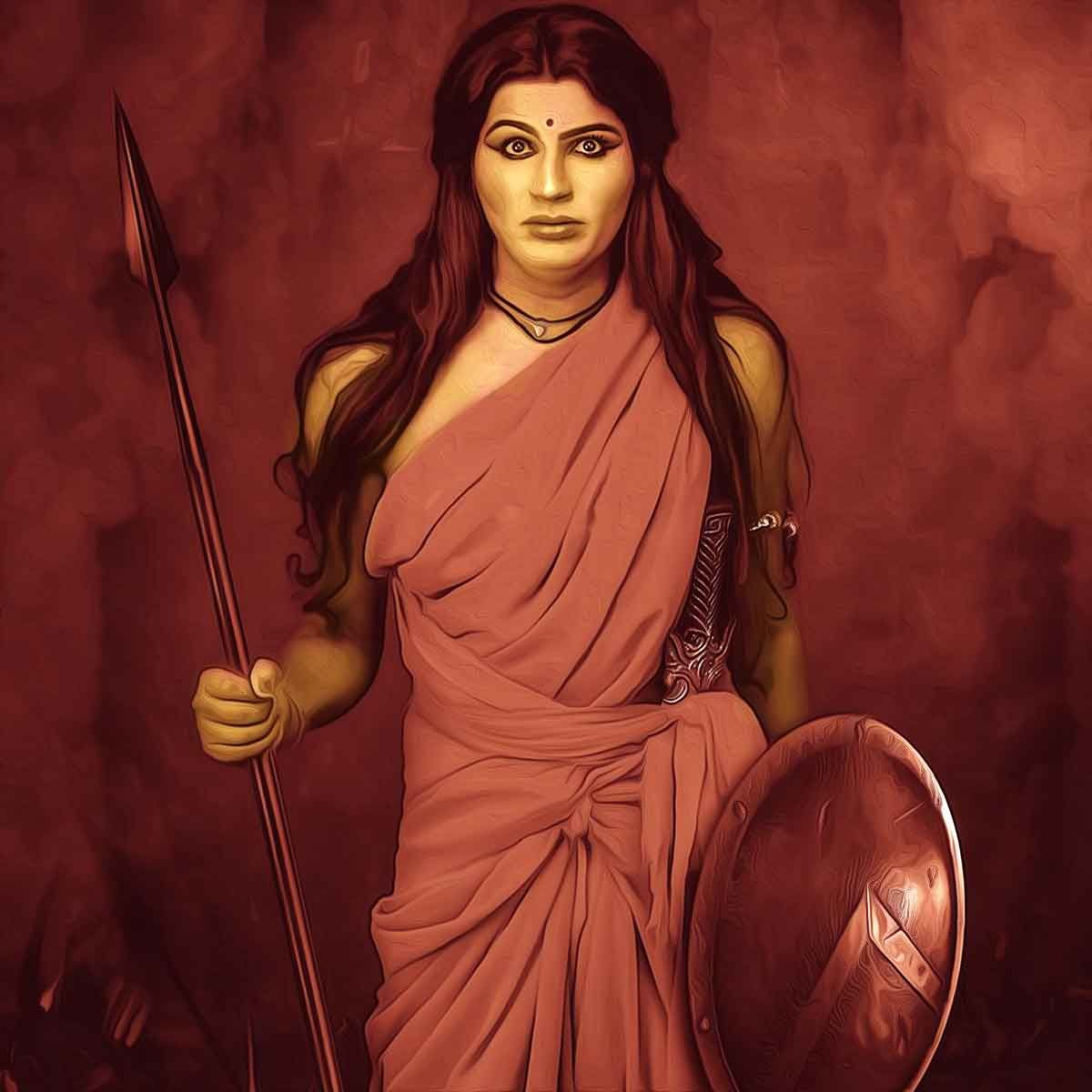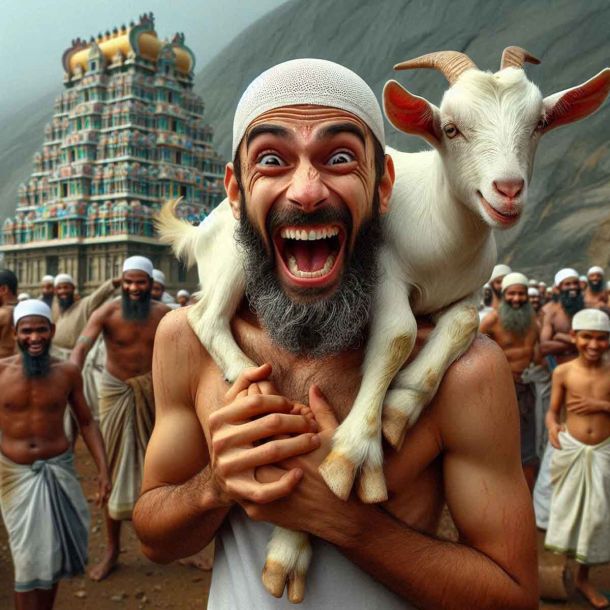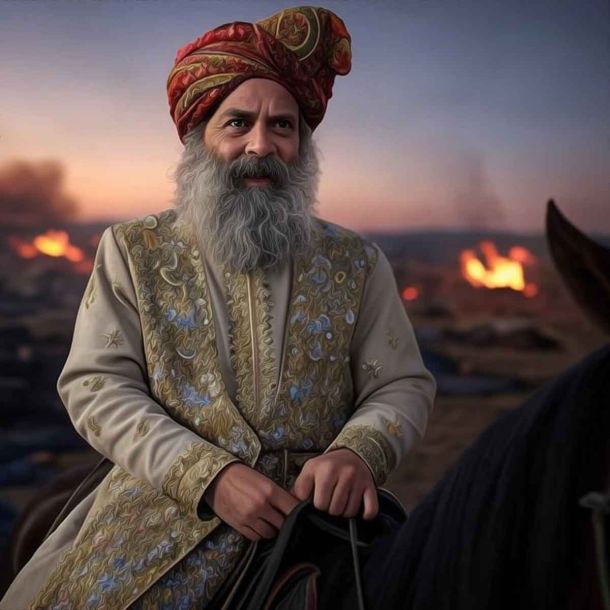More Coverage
Twitter Coverage
Satyaagrah
Written on
Satyaagrah
Written on
Satyaagrah
Written on
Satyaagrah
Written on
Satyaagrah
Written on
Join Satyaagrah Social Media
"Kuyili - the first suicide bomber of India during freedom struggle": Army commander of queen Velu Nachiyar poured ghee over herself and entered ammunition warehouse of Britishers resulting in an explosion that defeated British

History books will never tell you who Velu Nachiyar was, or that she was the first ever queen from India to have bravely rebelled against the British forces. Neither will they mention Kuyili, who was the commander of Velu’s army, and gave the British East India Company a real run for their money!
Except in Tamil Nadu, both women are relatively unknown across the country despite their epic warfare tactics and historic win against the British in the eighteenth century, and we take this opportunity to share a little-known heroic saga of probably one of the first movements of active and violent resistance against the colonial oppressors.
The very utterance of the term ‘human bomb’ will transport you to a terrain of horror, of some violent attack wherein the attacker dies during the action. You will only visualize the harm, damage, and destruction that it may cause to life and property. But this is no story about any hostile individual. We are delving about a brave lady warrior who became a human bomb for the sake of the motherland. She did not carry any bomb but set herself ablaze at the guns and ammunition storehouse of the British. As a result, the warehouse exploded and all guns and ammunition British stored in the warehouse were destroyed. This helped Rani Velu Nacchiyar easily defeat the British. She is long forgotten and wiped away from the pages of History. Many of us aren’t aware of or familiar with her. She was Kuyili of Tamil Nadu.
Kuyili was the commander of the Udayal Padai contingent of the women's army of Velu Nacchiyar, the queen of Sivagangai, Tamil Nadu. A warrior to the core, she was known for her valor and unconditional love for her motherland, always ready to sacrifice her life. She was a faithful follower of the queen. Velu Nacchiyar trusted her the most.
|
Not much information about Kuyili’s birth and childhood is available in records. She was born at Kudanchavadi near Sivagangai. She belonged to the Sambavar community from Tamil Nadu. ‘Sambavar’ draws its origin as followers of Mahadev. They are believed to be ancient priests of Mahadev. Sambavars find mentioned in History and other records as warriors, priests, agriculturalists, poets, writers, dancers, and musicians.
Velu Nacchiyar was married to Muthuvaduganathaperiya Udaiyathevar, the king of Sivagangai. The couple was blessed with a daughter. The year was 1772, when Muthuvaduganathaperiya Udaiyathevar, the second king of Sivaganga, was embroiled in a war with the Nawab of Arcot for refusing to yield to his demands.
Although the king could have easily managed to fight against the Nawab’s army had it comprised soldiers from the local population, what ended up being problematic and later, fatal, for the former, was the direct involvement of the British troops, who were fighting wars for the Nawab, through a strategic partnership. Shortly after, the town of Sivaganga was attacked and ravaged by two British officers, who managed to get through to Udaiyathevar’s defense forces lined up in the neighboring Kalayar Kovil forests and take the king down in the battle that ensued, along with many of his citizens.
Muthuvaduganathaperiya Udaiyathevar was killed in a battle against the combined forces of the British and Nawab of Arcot at Kalaiyar Koil on 25 June 1772. The invading British army plundered Kalaiyar Koil and collected jewels worth 50,000 pagodas.
Velu Nachiyar was Thevar’s wife and mother of their infant daughter, Vellachi, and their lives came to a standstill following Thevar’s unexpected martyrdom. A woman of rare intellect who was way ahead of her time, Velu’s skill in learning new languages as well as her combating abilities were already well known, and it is believed that her bravery and impressive scholarly knowledge was what won Thevar’s heart before they entered into wedlock.
So, when Sivaganga fell, surrendering to the British was probably the best option to save one’s head sans honor, but Velu had other plans in her mind. Rani Velu Nacchiyar fled with her daughter Vellacchi to Virupachi, a neighboring kingdom ruled by Palayakaarar Kopaala Naayakkar.
However, for a fugitive queen to singlehandedly fight against one of the strongest armies in the world with neither military support nor strategies was like entering the lion’s den with no arms or ammunition. As much as she’d been hurting, Velu didn’t want to be carried away with emotions, so, she patiently waited for the right opportunity. She was all determined to take vengeance against the British. She remained in hiding at Virupachi near Dindigul for eight years.
Dindigul was located at a distance of around 100 km from Sivagangai. During the eight long years in hiding, she managed to arrange a huge army. Her army also included a big contingent of women warriors under the banner of Udayal Padai in memory of Udayal, who sacrificed her life for the queen. This wing was commandeered by Kuyili. Velu Nacchiyar herself trained them to perfection. Kuyili was a beauty with brains and was one of the ablest of the queen’s commanders.
Following much planning and deliberation, Velu finally zeroed in on a person from the South as a possible ally, who already had a notorious past with both the Nawab and the British. The man whom she had sought for help through a letter was Hyder Ali, and following their meeting in person, Ali seemed to be quite impressed with the queen’s unwavering resolve to overthrow the British and offered to give her everything she needed—in terms of men and arms.
More than determination, legend has it that her innate command over languages (Urdu in this instance) was what won her a powerful ally as she was inching closer to retribution.
In 1780, Velu Nacchiyar allied with two neighboring rulers and was all geared up for a war against the British. She marched with her allies and army towards Sivagangai. On the way, they encountered enemy troops at intervals, first at Madurai Kochadai, then at Thirubuvanam, and Kalaiyar Koil. The queen’s army defeated the enemy forces at all three places.
The queen and her army were now on their way to Sivangangai to recapture the fort and drive away the British from the city. At this juncture, her spy from Sivagangai alerted the troops and advised them not to march towards Sivagangai at the moment as British troops were all ready with heavy guns and ammunition including cannon barrels at several places at a distance of a kilometer each in and around Sivagangai.
The enemy British forces were superior in terms of guns and ammunition using which they could kill their opponents from a long distance. Rani Velu Nacchiyar wished that the enemy’s ammunition and guns were destroyed so that she could successfully achieve victory. Marching ahead at this time would only mean casualties for her army and a possible defeat. The spies also told that the British stored the guns and ammunition at a warehouse inside the Raja Rajeswari temple at Sivagangai palace.
The queen and her army set up camps to wait till the situation in Sivagangai calmed down. She held a meeting with the commanders including Kuyili and discussed the future course of action.
Kuyili happened to see a group of women at a distance walking barefoot towards the route to Sivagangai. They looked like devotees. She rushed towards them. During ancient and medieval times, and to this day, devotees on particular festive occasions walk several miles to visit and offer prayers at their favorite places of worship. Kuyili asked them where they were heading to. They replied that the next day was Vijayadashami. And that they were heading towards Raja Rajeswari temple dedicated to Shakti and Mahadev located within the Sivagangai palace premises. It was only on Vijayadashami day that the British allowed entry of women to the Raja Rajeswari temple for worship.
Kuyili walked back towards the camp. An idea struck her mind. She immediately devised a plan and discussed it with the queen. She undertook complete responsibility by volunteering for the task. She chose the next day — Vijayadashami for executing her plan. Velu Nacchiyar readily gave her consent to the commander’s plan.
The brave Kuyili divided the Udayal Padai wing into groups. She instructed all the women soldiers step by step on what they would be doing. They all disguised as devotees and hid weapons tucked under their sarees. Velu Nacchiyar, also disguised, mingled in the group. And the groups, one after another, headed towards Raja Rajeswari temple. Three rounds of worship were to be carried out at the temple, which the queen and the women army were well familiar with. They strategized to strike after the third round after the general devotees would leave.
As decided, after the third round of worship after maximum devotees left, Kuyili, Velu Nacchiyar, and the women's army attacked the British. Captain Benjour and the entire British troop were taken unawares. In a short while, many British soldiers were slain. British sepoys rushed towards the warehouse in the temple to bring ammunition.
Allowing the British to bring ammunition from the warehouse would mean heavy casualties for the Udayal Padai soldiers. The warehouse had to be destroyed. Kuyili immediately rushed towards the deity where a large ghee oil lamp was burning. Two British sepoys shot at her. The wounded Kuyili rushed forward. There was a pot of ghee oil nearby. The valorous woman captain poured the ghee from the pot and emptied it over herself. Holding the ghee oil lamp, she rushed towards the warehouse. British sepoys rushing towards the warehouse suddenly stopped as they realized what was going to happen. In no time, the warehouse exploded. Kuyili had lit herself in the warehouse turning into a human bomb. She perished and turned into ashes in no time. But her sacrifice led to the destruction of the warehouse of guns and ammunition by the British forces.
|
A face-to-face fierce battle ensued between the British and Rani Velu Nacchiyar’s forces. More of Rani’s forces joined the battle. The British stood no chance before the queen’s mighty warriors. They were defeated. Captain Benjour surrendered. He pleaded to beg for his life at the same time promising that the British would never interfere in the affairs of the Sivagangai kingdom in the future. Velu Nacchiyar spared the captain’s life and set him free.
She ruled the kingdom for over a decade before bequeathing the royal commitments to the Maruthu brothers at her death in 1796.
Although Velu Nachiyar is still held in high regard in Tamil Nadu with the moniker ‘Veeramangai’ or brave woman bestowed upon her by the people, Kuyili’s name has somehow faded away from the public memory, except for a memorial in the Sivaganga district by the state government that was erected only recently.
Before the so-called first war of Indian Independence of 1857 took place or even before the legendary duo of Rani Laxmi Bai and Jhalkari Bai of Jhansi revolted against the British Raj, two women warriors from the South dared to fight for their birthright and gave the colonialists an answer they’d never forget.
Rani Velu Nacchiyar regained her kingdom, all because of the supreme sacrifice by Kuyili. Though our history books fail to mention or credit these women for their extraordinary contribution to our freedom from a two-century-long colonial rule, the legacy of Velu Nachiyar and Kuyili will live on through local legends and word of mouth.
Jai matribhumi, Jai Hind.
|
References:
thebetterindia.com
en.wikipedia.org
udayavani.com
Saffron Swords: Centuries of Indic Resistance to Invaders - Manoshi Sinha Rawal, Yogaditya Singh Rawal
 Support Us
Support Us
Satyagraha was born from the heart of our land, with an undying aim to unveil the true essence of Bharat. It seeks to illuminate the hidden tales of our valiant freedom fighters and the rich chronicles that haven't yet sung their complete melody in the mainstream.
While platforms like NDTV and 'The Wire' effortlessly garner funds under the banner of safeguarding democracy, we at Satyagraha walk a different path. Our strength and resonance come from you. In this journey to weave a stronger Bharat, every little contribution amplifies our voice. Let's come together, contribute as you can, and champion the true spirit of our nation.
 |  |  |
| ICICI Bank of Satyaagrah | Razorpay Bank of Satyaagrah | PayPal Bank of Satyaagrah - For International Payments |
If all above doesn't work, then try the LINK below:
Please share the article on other platforms
DISCLAIMER: The author is solely responsible for the views expressed in this article. The author carries the responsibility for citing and/or licensing of images utilized within the text. The website also frequently uses non-commercial images for representational purposes only in line with the article. We are not responsible for the authenticity of such images. If some images have a copyright issue, we request the person/entity to contact us at This email address is being protected from spambots. You need JavaScript enabled to view it. and we will take the necessary actions to resolve the issue.
Related Articles
- "Courage makes a man more than himself; for he is then himself plus his valor": Surya Sen - hero behind Chittagong armory raid & attack on Europeans only club that shook British like never before, brutally tortured and executed by British on Jan 12, 1934
- Bhagat Irwin Gandhi - Martyrdom of Shaheed Bhagat Singh (Some Hidden Facts)
- "Purify your hearts with the water of love of motherland in national temple, and promise that millions will not remain untouchables, but brothers and sisters": Swami Shraddhanand, who awoke Hindu consciousness
- Birth of our National Anthem: Original recording of 'Jana Gana Mana' performed by the Radio Symphony Orchestra of Hamburg, Germany, 1942 in the presence of Netaji Subhash Chandra Bose
- Hero of Pawankhind: Veer Maratha Bajiprabhu Deshpande, who led 300 Soldiers against 12000 Adilshahi Army defending Shivaji
- "Victory are reserved for those warriors who are willing to pay it's price": One of the greatest and undefeated General Zorawar Singh conquered Laddakh, Tibbat,Gilgit, Skardu, Baltistan and defeated army of Imperial Chinese Tibetans in Dogra-Tibetan War
- Tirot Singh: An Unsung Hero of the Khasi Tribe who destroyed British with his skill at Guerrilla Warfare
- "दधीचि": Jatin Das, hailed by Netaji as the "Young Dadhichi," fasted unto death for 63 days in Lahore Jail, enduring brutality while protesting British tyranny, his martyrdom ignited national outrage, inspiring millions in the fight for India's freedom
- Debunking the myth of "De Di humein Aazadi Bina Khadag Bina Dhal": Bharat’s founding story bestows upon it an extravagant national philosophy and long-lasting costs
- Godse's speech and analysis of fanaticism of Gandhi: Hindus should never be angry against Muslims
- "Arriving at one goal is the starting point to another": CM Bommai and Speaker VH Kageri unveils the portrait of revolutionary freedom fighter Veer Savarkar in the Assembly hall of the Suvarna Vidhana Soudha in Belagavi, Congress stages protest
- "Remember that the greatest crime is to compromise with injustice and wrong": NSA Ajit Doval during the inaugural at Netaji Subhas Chandra Bose Memorial event in New Delhi claimed that "India would not have been partitioned if Subhas Bose was alive"
- "True icons are larger than life, unforgettable with an elegance that's mesmerizingly timeless": Do you know on occasion of birth anniversary celebrations of Netaji Bose on 23 Jan 1949, Ukkirapandi Muthuramalinga Thevar announced that Bose was alive
- Unsung Heroine Pritilata Waddedar, Who Shook The British Raj at the age of 21
- Film based on Nathuram Godse ‘Why I killed Gandhi’ gets opposition from Congress party demanding to ban the movie in Maharashtra, Cine Workers Association seek nationwide ban
























